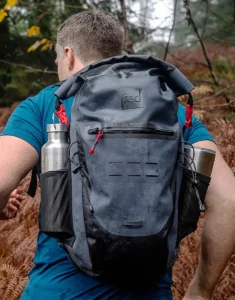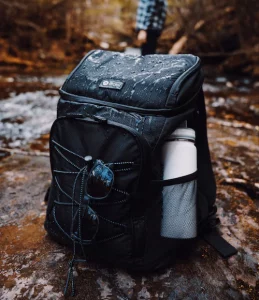Introduction
When it comes to outdoor adventures, having a reliable and waterproof backpack can make a world of difference. Whether you’re hiking, camping, or simply commuting in unpredictable weather conditions, keeping your belongings dry and protected is essential. In this article, we will guide you through the process of waterproofing your backpack, ensuring that it remains resilient against rain, and how to Waterproof a Backpack.
Importance of Waterproofing a Backpack

Waterproofing a backpack is crucial for several reasons. Firstly, it helps to keep your belongings safe and dry, preventing any damage or deterioration. Whether it’s your clothes, electronics, or important documents, waterproofing ensures that they remain unaffected by rain or accidental spills.
Secondly, a waterproof backpack extends its lifespan by protecting the fabric and preventing mold or mildew growth. Lastly, having a waterproof backpack gives you peace of mind, allowing you to focus on your outdoor activities without worrying about your valuables getting soaked.
Whether you’re caught in a sudden rainstorm or trekking through wet environments, having a waterproof backpack gives you peace of mind, knowing that your items are shielded from moisture.
Additionally, waterproofing helps extend the lifespan of your backpack. Exposure to moisture can cause the fabric to deteriorate, leading to weakened seams or potential mold and mildew growth. By implementing proper waterproofing measures, you safeguard your backpack’s integrity and durability, enabling it to withstand the test of time and frequent use.
Assessing the Backpack’s Material and Construction
Before proceeding with waterproofing, it’s essential to assess your backpack’s material and construction. Different backpacks may require different waterproofing methods. Check the manufacturer’s instructions or do some research to determine the best approach for your specific backpack.
Consider factors such as the fabric type, seams, zippers, and any additional features that may impact the waterproofing process.
Identify the type of material your backpack is made of. Common materials include nylon, polyester, canvas, or specialized fabrics like Gore-Tex. Each material may require different waterproofing techniques and products. Refer to the manufacturer’s instructions or conduct research to understand the specific characteristics of your backpack’s material.
Evaluate the quality and condition of the zippers. Are they water-resistant or equipped with waterproof coatings? Waterproof zippers prevent water from seeping through the zipper teeth. If your backpack has water-resistant zippers, it can enhance the overall waterproofing capability.
However, if the zippers are not designed for water resistance, you’ll need to ensure adequate waterproofing around the zipper areas.
Preparing the Backpack for Waterproofing
To ensure effective waterproofing, it’s important to prepare your backpack properly. Start by cleaning it thoroughly. Remove any dirt, dust, or debris using a mild detergent or soap.
Pay close attention to the corners, pockets, and straps. Once clean, inspect the backpack for loose threads or damaged zippers. Repair or replace any faulty components before proceeding with waterproofing.
Cleaning the Backpack: Before applying any waterproofing product, start by cleaning your backpack thoroughly. Use a mild detergent or soap and a soft-bristled brush to remove dirt, debris, and stains. Pay attention to the corners, straps, and hard-to-reach areas. Rinse the backpack thoroughly and allow it to dry completely before proceeding.
Removing Loose Threads or Damaged Zippers: Inspect your backpack for loose threads, frayed edges, or damaged zippers. These vulnerabilities can compromise the effectiveness of the waterproofing treatment.
Carefully trim any loose threads and repair minor damages. If the zippers are damaged beyond repair, consider replacing them to ensure a secure closure that prevents water from seeping through.
Choosing the Right Waterproofing Method
There are several methods available for waterproofing a backpack, each with its own advantages and application techniques.
These products are suitable for synthetic fabrics like nylon or polyester. They create a protective layer on the backpack’s surface, causing water to bead and roll off. Waterproof sprays and DWRs are easy to apply and widely available. Ensure you choose a spray specifically designed for outdoor gear and follow the manufacturer’s instructions for optimal results.
Ideal for backpacks made of canvas or waxed cotton, waterproofing waxes provide a natural, water-repellent barrier. To use, melt the wax and apply it evenly to the fabric using a clean cloth. Pay special attention to seams and high-friction areas.
If your backpack lacks inherent waterproofing properties, using a waterproof liner or cover can provide an effective solution. These liners enclose the backpack and shield it from moisture. They are particularly useful for heavy rain or water-based activities. Ensure the liner fits properly and covers the entire backpack, including openings and straps.
Consider the specific material of your backpack, its intended use, and your personal preferences when choosing the waterproofing method. Some backpacks may benefit from a combination of methods. Experimentation and testing on a small area are recommended before treating the entire backpack to ensure compatibility and desired results.
Step-by-Step Guide to Waterproofing a Backpack

Now that you have chosen the appropriate waterproofing method, follow these steps to waterproof your backpack effectively:
Gather the Necessary Materials
-
- Waterproofing product (spray, wax, sealant, liner, etc.)
- Clean cloth or sponge
- Mild detergent or soap
- Soft-bristled brush (optional)
- Hairdryer (optional)
On a Small Area, Test the Waterproofing Product
Before applying the waterproofing product to the entire backpack, perform a patch test on a small, inconspicuous area. This will help you ensure compatibility and assess the desired level of waterproofing.
Select a small area on your backpack that is not easily visible. This can be an interior section or a hidden corner where any potential discoloration or adverse effects won’t be noticeable.
Apply a small amount of the waterproofing product to the chosen area. Use a clean cloth or sponge to spread the product evenly. Pay attention to how the product interacts with the material and observe its effect.
Apply the Waterproofing Product to the Backpack
Follow the instructions provided with the chosen waterproofing method. Apply the product evenly to the backpack’s surface, focusing on seams, zippers, and other vulnerable areas. Use a clean cloth or sponge to spread the product and ensure complete coverage.
Ensure Proper Coverage and Absorption
Allow the waterproofing product to penetrate the fabric for optimal coverage and absorption. Pay attention to any areas that may require additional layers or attention, such as the bottom of the backpack or high-friction zones.
Allow Sufficient Drying Time
Once the product is applied, allow the backpack to dry completely before using it or exposing it to moisture. Follow the manufacturer’s instructions regarding drying time, and consider using a hairdryer on a low setting to speed up the process if necessary.
Additional Tips for Waterproofing Success
- Avoid Overapplication: Applying excessive amounts of the waterproofing product may lead to uneven coverage or affect the backpack’s breathability. Follow the manufacturer’s guidelines for the recommended amount to apply.
- Reapply Waterproofing as Needed: Over time and with regular use, the waterproofing effectiveness may diminish. Keep an eye on your backpack’s performance and reapply the waterproofing product as necessary.
- Storing the Waterproofed Backpack Properly: To maintain waterproofing quality, store your backpack in a cool, dry place when not in use. Avoid leaving it exposed to direct sunlight or high humidity, as these factors can degrade the waterproofing over time.
Benefits of Waterproofing Your Backpack
- Protection from Rain, Snow, and Moisture: By waterproofing your backpack, you safeguard your belongings against unexpected weather conditions, ensuring that everything inside remains dry and intact.
- Extending the Lifespan of Your Backpack: Waterproofing helps protect the fabric and prevent damage caused by moisture, which can lead to mold, mildew, or fabric deterioration. By maintaining a waterproof barrier, you extend the lifespan of your backpack.
- Safeguarding Your Valuables and Electronics: Valuables such as smartphones, cameras, or laptops are often carried in backpacks. Waterproofing adds an extra layer of protection, shielding these items from potential water damage.
FAQ
Is waterproofing a backpack a one-time process?
Waterproofing may require occasional reapplication, especially after extensive use or exposure to harsh weather conditions. Monitor the effectiveness of the waterproofing and reapply as needed.
Can I use the same waterproofing method for all types of backpacks?
Different backpack materials may require specific waterproofing methods. Synthetic fabrics, canvas, or coated materials each have their own suitable products and techniques. Research the best method for your specific backpack.
How long does the drying process take after applying the waterproofing product?
Drying times vary depending on the product and environmental conditions. Follow the manufacturer’s instructions for the recommended drying time, and allow sufficient time for the product to fully dry before using the backpack.
Can I machine wash a waterproofed backpack?
Machine washing may compromise the waterproofing. Check the manufacturer’s instructions for cleaning recommendations specific to your waterproofed backpack. Hand washing is generally safer.
Can I speed up the drying process by using a hairdryer?
Yes, you can use a hairdryer on a low setting to help expedite the drying process. Ensure the heat setting is not too high to avoid damaging the backpack or the waterproofing product.
Conclusion
Waterproofing your backpack is a vital step in ensuring the safety and longevity of your outdoor gear. By understanding the different waterproofing methods, properly preparing your backpack, and following the step-by-step guide, you can enjoy your adventures without worrying about your belongings getting wet. Keep your backpack dry, protected, and ready for any weather conditions.
How to carry water backpacking: Tips for Efficient Hydration

